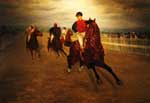VAM galleries including this work:
The Kentucky Derby Museum | Animal Farm | Seeing Red || VAM Home
Gean Smith (New York, 1851-1928)
JIM GRAY WINNING THE STALLION STAKES,
c. late 19th century
Oil on canvas; 9' X 11'
Donated by Norman B. Casse, 1984.53
The Kentucky Derby Museum
This painting—which depicts the horse Jim Gray winning the Great American Stallion Stakes at Churchill Downs on September 17, 1886—has an interesting history. After being exhibited at the National Arts Club of New York and the Chicago World’s Fair in the 1890s, it disappeared from the public eye in the early 1900s. In the late 1970s, Derby Museum member Norman Casse found it hanging as a wall decoration in a Wisconsin tavern. It was donated to the Kentucky Derby Museum in 1984 and sent to the Chicago Conservation Center for repair and restoration in 1989. The painting was returned to the museum in the early 1990s.
About the Artist
Gean Smith was born in New York in 1851. A self-taught artist, he was an avid painter of horses, dogs, and Western animals. He spent roughly 40 years painting in his studio in New York City before settling down in Galveston, Texas, in the 1920s.
Classroom Ideas
Discussion: Paintings often convey one or more aspects of their subjects’ personalities. Do you think this holds true for equine and other animal art? Use the magnify option to take a closer look at Jim Gray’s facial expression. What does it tell you about how the horse might be feeling at the moment portrayed?
Activity: Jim Gray Winning the Stallion Stakes is a massive picture. To get a better sense of its size, use a yardstick and chalk to draw a 9-foot by 11-foot rectangle on the floor. What goes into creating large works? Do larger paintings work better for some subjects than others? Sketch a composition that you think would look best on a large scale. On a large masonite board (available at hardware stores), use acrylic paint to re-create your sketch. If you prefer, you can make this a group project. When you are done, discuss some of the drawbacks and benefits you discovered about painting a large-scale work.
Links
See another work by Gean Smith in the Texas State Capitol Art Collection (from the Traditional Fine Arts Organization web site).
[www.tfaoi.com/aa/1aa/1aa4b.htm]

